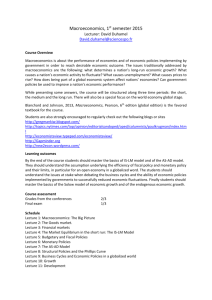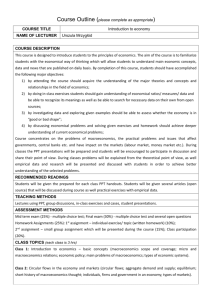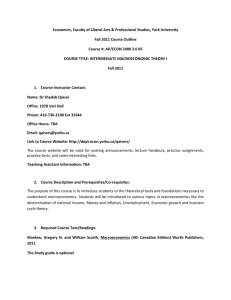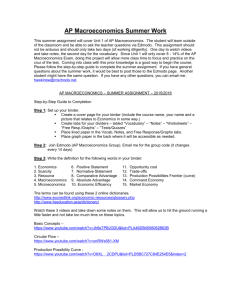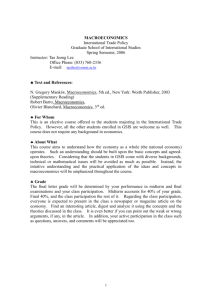Macroeconomics I
advertisement
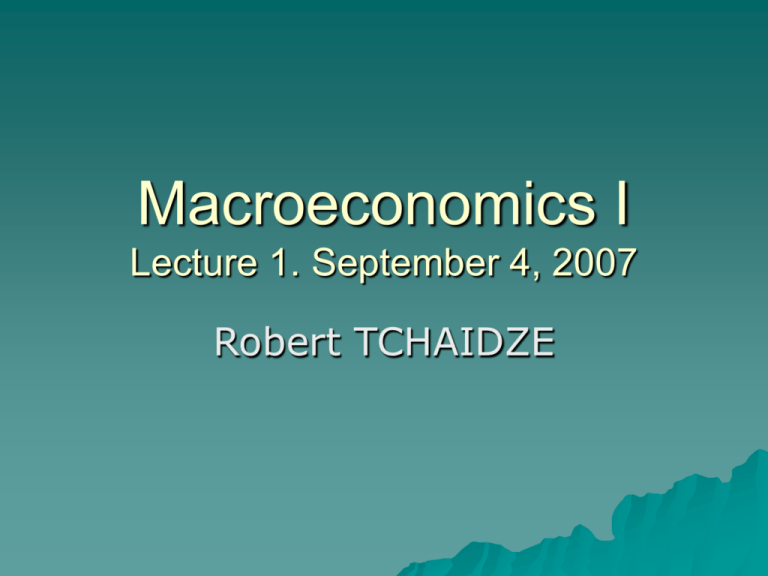
Macroeconomics I Lecture 1. September 4, 2007 Robert TCHAIDZE Logistics TAs: Bakari Baratashvili, Anastasia Shchepetova Emails: – robert@iset.ge – b.baratashvili@iset.ge – a.shchepetova@iset.ge Office hours: – RT: Wednesday 2-4. – BB and AS: to be announced … Textbook: Mankiw Weekly problem sets September 4, 2007 MACROECONOMICS I 2 Economics as a science Economics is not about making money. It does help though. Economics is about human behavior, incentives, interactions, and outcomes. Economics is about setting “the rules of the game” that ensure appropriate (but what exactly is appropriate?) outcomes. Economics is a growing science, not all the interaction channels are studied well enough. Not even clear if we know about all channels. Given the goals of society, what policies and in what manner can/should the government pursue? September 4, 2007 MACROECONOMICS I 3 What is Macroeconomics about? What determines and causes movements in the important economic variables: – Output (real GDP) and its growth rate – Inflation – Unemployment Other variables: – – – – Interest rates Budget balance Current account balance Level of debt (external, public, …) September 4, 2007 MACROECONOMICS I 4 U.S. Real GDP per capita (2000 dollars) 40,000 9/11/2001 First oil price shock 30,000 long-run upward trend… 20,000 Great Depression Second oil price shock 10,000 World War II 0 1900 1910 1920 1930 1940 1950 1960 1970 1980 1990 2000 September 4, 2007 MACROECONOMICS I 5 U.S. inflation rate (% per year) 25 20 15 10 5 0 -5 -10 -15 1900 1910 1920 1930 1940 1950 1960 1970 1980 1990 2000 September 4, 2007 MACROECONOMICS I 6 U.S. unemployment rate (% of labor force) 30 25 20 15 10 5 0 1900 1910 1920 1930 1940 1950 1960 1970 1980 1990 2000 September 4, 2007 MACROECONOMICS I 7 Questions asked: Why does the cost of living keep rising? Why are millions of people unemployed, even when the economy is booming? What causes recessions? Can the government do anything to combat recessions? Should it? What is the government budget deficit? How does it affect the economy? Why does the U.S. have such a huge trade deficit? Why are so many countries poor? What policies might help them grow out of poverty? September 4, 2007 MACROECONOMICS I 8 Caveats: Short-run implications may be different from long-run ones: – If government cuts income taxes than consumption increases in the short run. In the long run government will have to cut its expenditures or raise taxes. What instruments to use: – Fiscal policy: taxes, government expenditures – Monetary policy: interest rates, exchange rate policy, reserve requirements September 4, 2007 MACROECONOMICS I 9 Economic models …are simplified versions of a more complex reality – irrelevant details are stripped away …are used to – show relationships between variables – explain the economy’s behavior – devise policies to improve economic performance September 4, 2007 MACROECONOMICS I 10 Economic models One model cannot address all the issues. Different models are used for studying different issues. For each model, one should keep track of – its assumptions; – which variables are endogenous (determined within the model) and which are exogenous (determined outside the model); – what questions can the model address and what questions it cannot. Different models can give different and even opposite answers. Models need to be tested empirically, i.e. it needs to be checked whether actual data patterns coincide with predictions of the model. September 4, 2007 MACROECONOMICS I 11 Output Nominal GDP – money value of final output of all goods and services produced during a period of time within the borders of a country. Value added=value of the output minus value of inputs. Instead of adding up value of final goods, GDP can be obtained as a sum of economy wide value added. GDP measures total output, total income, total expenditure. Other concepts – GNP, NNP, National Income (net of indirect business taxes). More appropriate to look at GDP per capita. September 4, 2007 MACROECONOMICS I 12 Problems with the concept of GDP Ignores … –… –… –… –… –… –… –… distribution; household work; underground economy; leisure; ecological costs; quality of life; technological improvements. September 4, 2007 MACROECONOMICS I 13 Real GDP n GDPt p1,tY1,t p2,tY2,t ... pn ,tYn ,t pi ,tYi ,t N i 1 n GDPt R p1, 0Y1,t p2, 0Y2,t ... pn , 0Yn ,t pi , 0Yi ,t i 1 Roughly speaking measures today’s production at yesterday’s prices. U.S. nominal GDP in 1996 was about 14 times higher than in 1959. But prices have increased 5 times. Hence, real GDP grew only about 3 times. Population grew by about 50 percent. Hence, real GDP per capita increased only twice. September 4, 2007 MACROECONOMICS I 14 Inflation GDP deflator (implicit price deflator) = Nominal GDP / Real GDP. It includes all the goods produced in the economy. It includes only domestically produced goods. It is a weighted average of changes in prices. IPDt 1 p1,t p1,0 2 p2 ,t p2 , 0 ... n pn ,t pn , 0 1 2 ... n 1 September 4, 2007 MACROECONOMICS I 15 Consumer Price Index Includes domestic and imported goods. Is based on an average basket of goods. Is an average but with fixed weights IPDt 1,t p1,t p1, 0 2 ,t p 2 ,t p2 , 0 ... n ,t p n ,t pn , 0 1,t 2,t ... n ,t 1 CPIt 1 p1,t p1, 0 2 p 2 ,t p2 , 0 ... k p k ,t pk , 0 1 2 ... k 1 September 4, 2007 MACROECONOMICS I 16 Problems with CPI It overstates inflation because it is based on a fixed basket; does not reflect properly introduction of new goods; does not reflect properly changes in quality of goods. One more problem from policymakers’ point of view is that it includes very volatile components that are beyond their control. Hence, core CPI, e.g. CPI less food and energy. September 4, 2007 MACROECONOMICS I 17 Unemployment Unemployment is a fraction of those who would like to work but cannot find job. Labor force participation is a fraction of those who work or want to work. What is optimal level of unemployment? September 4, 2007 MACROECONOMICS I 18 Types of unemployment Frictional unemployment –due to normal turnover in the labor market. It includes people who are temporarily between the jobs, because they are moving or changing occupations for similar reasons. It is voluntary. Structural unemployment refers to workers who have lost their jobs because they have been displaced by automation, because their skills are no longer in demand, or for other similar reasons. Cyclical unemployment is attributable to a decline in the economy’s total production. It is positive during recessions and negative during booms. September 4, 2007 MACROECONOMICS I 19 Basic Demand-Supply Model A snapshot of the economy. I.e. levels of inputs are fixed and fully utilized. Y=F(K,L) F exhibits constant returns to scale: F(zK, zL)=z F(K,L) F exhibits decreasing marginal product of labor and capital. MPL = F (K, L +1) – F (K, L) For a given K, MPL decreases as L increases September 4, 2007 MACROECONOMICS I 20 MPL and the production function Y output F (K , L ) 1 MPL MPL As more labor is added, MPL 1 MPL Slope of the production function equals MPL 1 L labor September 4, 2007 MACROECONOMICS I 21 Determining Supply Profit = Revenue – Labor Cost – Capital Cost = PY – WL – RK ΔProfit = = ΔRevenue – ΔCost = = MPL P – W If MPL > W/P hire more MPL = W/P (MPL=real wage) MPK = R/P (MPK = real capital rent) September 4, 2007 MACROECONOMICS I 22 MPL and the demand for labor Units of output Each firm hires labor up to the point where MPL = W/P. Real wage MPL, Labor demand Units of labor, L Quantity of labor demanded September 4, 2007 MACROECONOMICS I 23 The equilibrium real wage Units of output Labor supply equilibrium real wage L September 4, 2007 MACROECONOMICS I The real wage adjusts to equate labor demand with supply. MPL, Labor demand Units of labor, L 24 The equilibrium real rental rate Units of output Supply of capital equilibrium R/P K September 4, 2007 MACROECONOMICS I The real rental rate adjusts to equate demand for capital with supply. MPK, demand for capital Units of capital, K 25 Determining Demand Y = C + I + G + NX This is an identity. It always holds. C – private consumption. Depends on disposable income Y – T. C=C(Y – T) G – government consumption. Assume to be fixed. Assume taxes T are fixed too. Investment is not a purchase of financial instruments. It is construction of new plants, purchases of new equipment, new housing, etc. Investment depends inversely on real interest rate. I = I(r). Assume a closed economy, where NX=0. September 4, 2007 MACROECONOMICS I 26 Equilibrium Y=F(K,L) NX = 0 C = C(Y – T) I = I(r) K, L, G, T are fixed. Hence, Y is fixed. Hence, C is fixed. Y – C – G = I(r) (Y – C – T) + (T – G) = I(r) Private Saving + Public Saving = Investment September 4, 2007 MACROECONOMICS I 27 Loanable funds market equilibrium r S Y C (Y T ) G Equilibrium real interest rate I (r ) S, I Equilibrium level of investment September 4, 2007 MACROECONOMICS I 28 Government spending increases… Logically: As supply of loans decreases, their price (real interest rate) increases. Crowding out. Mathematically: Y – C – G = I(r) As G increased, Y – C – G decreases In order for I(r) to decrease, r should rise. September 4, 2007 MACROECONOMICS I 29 Government spending increases… September 4, 2007 MACROECONOMICS I 30 Homework: Chapter 2, problem 7 (a, b, c, d) Chapter 3, problem 1 Chapter 3, problem 9 Due next Tuesday at 9 a.m. in class September 4, 2007 MACROECONOMICS I 31




